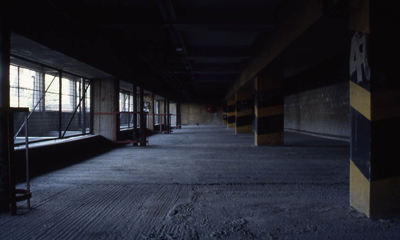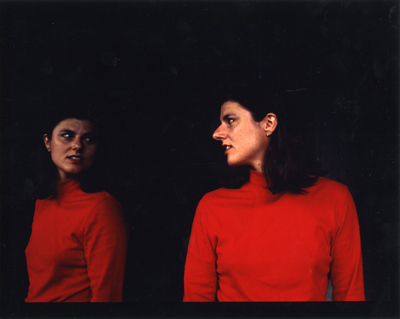Jacqueline Pennell
- Jacqueline Pennell – Press release
- Foreword, Mirror Mirror: Jacqueline Pennell – Rear Window
- The Other Site, Towards a Definition of Site-specificity – Jean-Paul Martinon
- From a Rear Window — Extract from a Journal – Peter Cross
- Mirror Mirror: Jacqueline Pennell – Rear Window
Foreword, Mirror Mirror: Jacqueline Pennell – Rear Window
Rear Window Publications
1996 ISBN 0 9521040 6 7
© Rear Window
This catalogue has been published to accompany the exhibition of Jacqueline Pennell Mirror Mirror, which took place in July, August, and September 1996 at Sara Lane Studios, Stanway Street, London N1. This exhibition was presented in the context of the Open Studios 1996 organised by the Whitechapel Art Gallery.
Jacqueline Pennell’s installation consisted of a corridor where architectural features on ceiling and walls were mirrored on the floor and at one end, reflecting the space back into itself. It explored the relevance of the studio space as a neutral habitat designed for the making of art and the purpose of this biennial opening ritual. The focus of her work centred on the viewer’s position when standing in an artist’s studio. The aim, which mirrored the thousands of other participating studios, was the “opening” to the public of a private space in which a piece of work had been conceived. However, in Pennell’s case, the viewer entered a domain where, because of the mirroring effect, it was uncertain who took the primary role on centre stage.
The traditional artist’s studio is a private space given over exclusively to the concept of creativity. This subjective separate activity, the creation of works of art, is given a new dimension by the opening of the studio to the public gaze. What is shown and what is hidden? What does the viewer experience when invading this private territory? What are the differences between an open studio and an open exhibition?
The traditional answers to these questions are that the work shown in open studios is either what galleries have rejected or is work “in progress,” and that what the viewer experiences is what the artist really wants him or her to experience, in other words, that which has not been censored or selected by a curator or a dealer. The open studio therefore is a unique showcase where the artist is given complete freedom to exhibit whatever he or she feels is “appropriate” to show. However, the general characteristic of an artist’s studio, its architectural and idiosyncratic features, show that, as in any exhibition space, the artist is still subservient to the ideology of the white cube.
The studio and gallery space have since the eighteenth century lost their ceiling and floor as potential exhibiting surfaces, each of which was sacrificed to artificial lighting and parquet flooring. Where the viewer was once asked to lift his or her eyes to Michelangelo’s frescoes or cast them down onto Pompeii’s mosaics, he or she is now required to face only the four whitewashed surfaces that form the white cube’s sole exhibiting surfaces and which the studio parodies. Jacqueline Pennell’s installation, which turned ceiling and walls into the piece itself, was a challenging and perplexing attack on the preconceived notion of where, and on what, art is made and shown.
This attack poignantly focused right at the core of the work Rear Window has concentrated for the last five years. By trying to show work outside traditional remits (i.e. the gallery or museum space), Rear Window, since its inception in 1992 has attempted to show that works of art can receive a new dimension if placed within a particular context, but also that art offers a unique understanding of sites which other practices, such as sociology, history, or literature, cannot grasp.
Jacqueline Pennell’s installation, instead of concentrating on the architectural, historical, or sociological aspects of the space (like, for example, Rear Window’s exhibition Care and Control at Hackney Hospital), focused on the preconceived notions of where and on what art works are shown and viewed. It centred not on the relationship between art and a particular space, but on the relationship between any art and any space. Its aim was to focus on the so-called neutrality of the space for art, whether it be a studio or a gallery space.
The following texts are three different attempts at understanding the concept of space for art and reflect the main preoccupations that have governed Rear Window for the last five years. In different ways, they try to bridge the gap between art and an omnipresent and unavoidable reality and show that they are not only interdependent, but also mutually informative.





